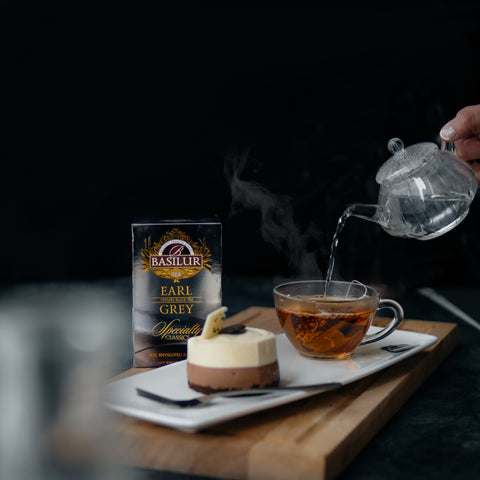The four types of tea (white, oolong, green, and black tea) are all made from the Camellia Sinensis plant, but their flavours are quite different from each other. This is because they are processed differently in order to achieve various levels of oxidation. Black tea is more oxidized than the other three types, for this reason, its flavour stays for several years, while green tea may lose its flavour within a year or a couple. Ceylon (Sri Lanka) is best known for its strong and flavourful black tea!
What makes Ceylon black tea different from green tea is that during the production process, the tea leaves are allowed to fully oxidize before they are heat-processed and dried. During oxidation, oxygen interacts with the tea plant’s cell walls to turn the leaves the rich dark brown to black color that black tea leaves are famous for. Oxidation alters the flavor profile of a black tea as well, helping add malty, fruity or even smoky notes, depending on the tea.
By contrast, when green tea leaves are processed, they are minimally oxidized. After being harvested, they are quickly heated and dried to prevent too much oxidation from occurring that would turn the green leaves brown and alter their fresh-picked flavor.
Black teas are typically produced using one of two methods:
- Orthodox: In this more time-consuming method of production, tea leaves remain whole or only partially broken during processing. Tea leaves are plucked from the garden, withered to reduce moisture, rolled in a variety of ways to bruise the leaves and start oxidation, oxidized to create color and flavor, fired to apply the heat that stops oxidation, and then graded for quality.
- Non-Orthodox or CTC (Crush-Tear-Curl): In this sped-up version of the production process, the tea leaves are cut into fine pieces instead of rolled. The smaller pieces of leaves are more quickly oxidized, producing one-dimensional, consistent, strong and bold black teas.
Here are some of our top black tea blends:
Earl Grey tea

English Breakfast tea

English Afternoon tea

Masala Chai

Black tea has a wide range of health benefits to offer including but not limited to;
- Abundancy in Antioxidants- polyphenols are a type of antioxidant common to tea and black tea has three types of them, comprising catechins, theaflavins, and thearubigins. Antioxidants can reduce the risk of chronic diseases because antioxidants can help get rid of free radicals in the body which reduces cell damage.
- No Risk in Type 02 Diabetes- research shows that a daily moderate consumption of black tea can reduce the chance of getting type 02 diabetes by 70%! For both healthy and pre-diabetic adults consuming black tea can reduce the blood glucose levels.
- Immune booster- the no sugar beverage is packed with amino acids, antioxidants, and alkylamine antigens that can strengthen our body and immune system, helping us fight off small maladies that we experience day to day.
- Aid in Cancer Cell Degrowth- the multi-tasking polyphenols also prevents the existence of cancer cells. A study showed that polyphenols reduced the growth of new cancer cells. While another study analyzed the effects of polyphenols on breast cancer, it showed that these polyphenols of black tea stopped hormone-dependent tumors from spreading inside the body.
- Caffeine’s Goodness- at first people may think caffeine is not good for health, but black tea’s caffeine content is quite low compared to that of coffee. A little bit of caffeine is needed in the human body to improve one’s concentration and awareness. Black tea also contains an amino acid known as L-theanine which improves brain activity and makes you feel energized after consuming a cup.
How you can Brew Black Tea

- In a saucepan bring water to a boil
- Measure out the tea leaves. A teaspoon of loose tea leaves for 200-250 ml of water is perfect.
- Place the tea leaves in the teapot and pour in the boiling water. Close the lid.
- After two minutes remove the lid and give your tea a stir, close the lid once more.
- Let the tea leaves steep for another additional 3 minutes.
- Once the tea is being steeped enough, place a strainer over your teacup and pour in the brewed tea.
- Serve and enjoy!




Comments (0)
There are no comments for this article. Be the first one to leave a message!